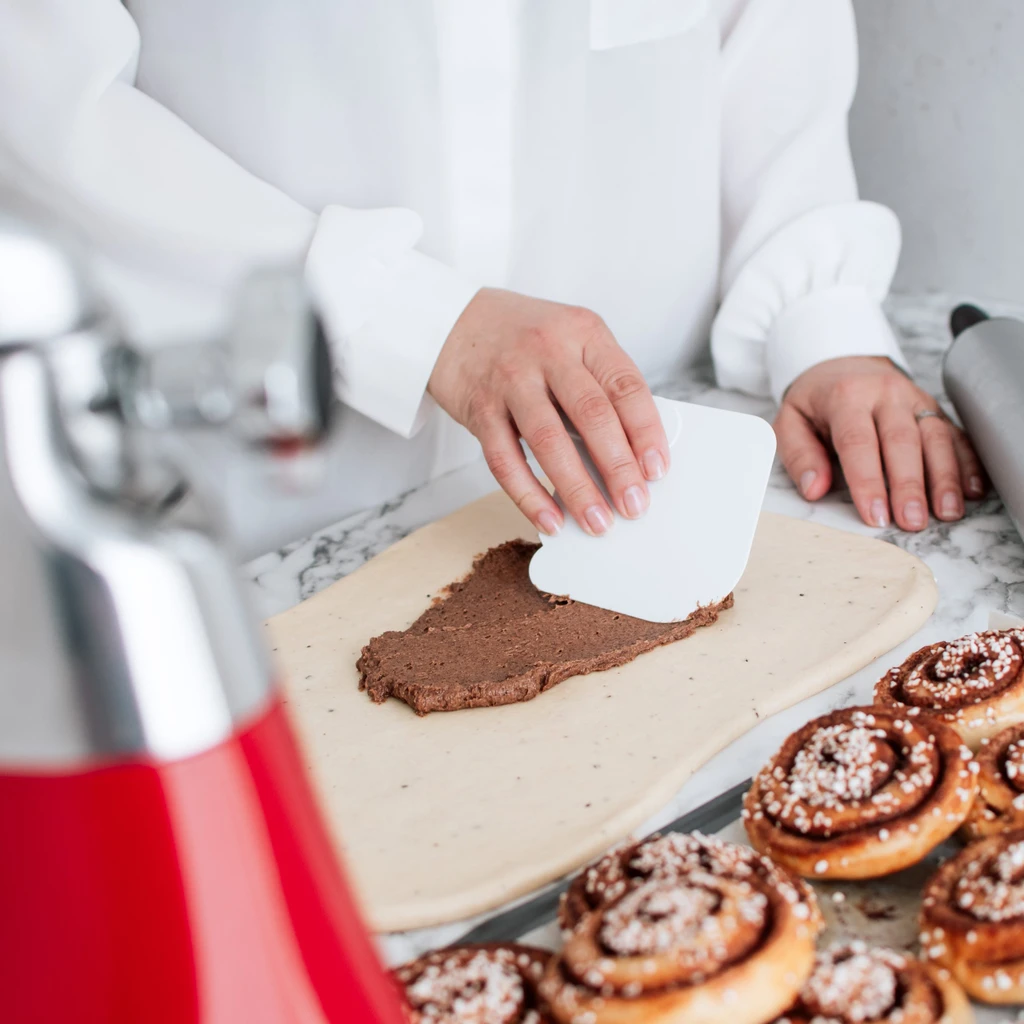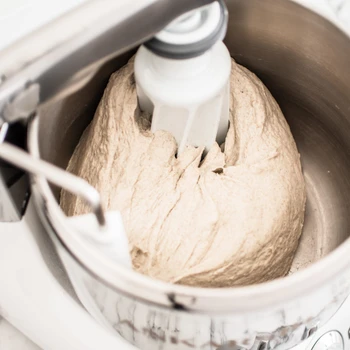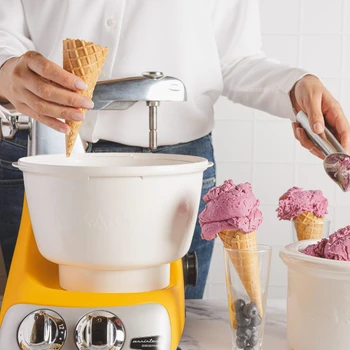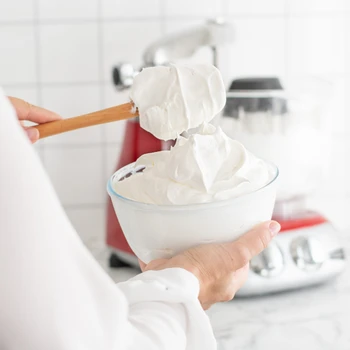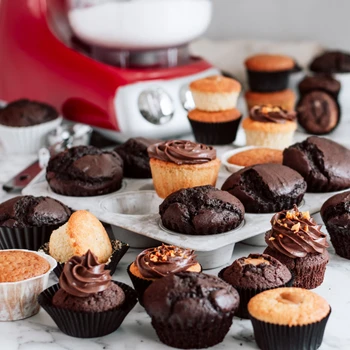Cinnamon buns are perhaps our most loved coffee bread and that is probably why there are so many different varieties of this particular wheat bread. Here are our tips to succeed with cinnamon bun baking!


Dough liquid
Most recipes specify milk as the dough liquid, but it is acceptable to use water, plant-based milk or a mixture of milk and water.
Less flour
In many recipes for cinnamon buns, it says “add a little flour at a time…” together with a relatively large difference in the amount of flour, for example 12-15 dl. Normally you need much less flour when the dough is kneaded in the assistant.
Both during kneading and rising, the dough gradually becomes firmer and less sticky, so do not add extra flour during kneading, even if the dough looks sticky. Do a windowpane test to see if the dough is fully kneaded.
Soft butter
Butter for the dough should be at room temperature, so plan ahead. This also applies to the butter for the filling.
If you use melted butter for the dough, it requires more flour, which in turn results in drier buns. Instead add soft butter in small pieces after mixing the other ingredients.
Tip! If the butter has not softened properly, you can use a cheese grater to shave thin slices which can be added to the dough.
Seasoning
Cinnamon, cardamom and vanilla are the spices wheat buns are usually flavored with, but feel free to try other flavors and variations. Browned butter, lemon, white chocolate, hazelnut cream, pistachio or chocolate go great in buns. Why not replace the caster sugar in the dough or the filling with, for example, brown sugar and get a more caramel-like flavor in the bun?
Vegan buns
The butter and milk can be replaced with plant-based alternatives.
Kneading
Knead the dough well in the machine, 10-18 minutes. The finished dough should be glossy and come away from the edges of the bowl.
Cold Fermentation
If you choose to cold or overnight ferment the dough, it will develop extra flavor and the dough becomes easier to work with.
To cold ferment an existing instant yeast bun recipe, you can halve the amount of yeast, use cold dough liquid instead of lukewarm, cover the bowl with a lid, ensuring there is room for the dough to rise, and refrigerate overnight.
Direct fermentation
The most common way to bake cinnamon buns is with two fermentations. One when the dough is in the bowl and resting just after kneading, and one when the buns are shaped and are on a baking sheet or in a form.
To directly leaven an existing bun recipe for cold leavened buns, you can double the amount of yeast, use lukewarm dough liquid and let the dough rise in the bowl for about 1 hour, until dough is doubled in size.
One fermentation
A variant of buns with a lot of butter, and which only rise once, is rimbo buns. The taste of the bread is reminiscent of puff pastry and is firmer than regular wheat bread. The dough is mixed and rolled out directly into buns and then allowed to rise once, slightly longer than normal buns, before baking.
Shaping
Smooth buns, filled, knotted, lengths, kibbles. Try baking the buns in a muffin tray or silicone molds, this will keep the filling contained, make sure to adjust the temperature, baking time and placement in the oven when baking off different shapes and sizes.
If buns are baked free-form on a baking tray, depending on shape, make sure dough seams are sealed or ends tucked under to ensure the buns stay together during rising and bake evenly. If you bake in bun tins, these will help hold the bun together.
Freeze unbaked buns
Unbaked and ready-made buns can be frozen as is. Let the buns thaw in the baking sheet for an hour or so before you bake them.
Brush
Brush the buns with beaten egg or milk before baking for a golden-brown color. This also helps any sugar sprinkled on top before baking stick to buns once baked. If you choose to brush your buns with sugar syrup after baking, you can skip the egg brushing.
Baking
In order for the buns to bake evenly, buns on the same baking sheet should be the same size and shape.
Preheat the oven to 250 degrees. Lower the temperature, if the recipe calls for it, 5-10 minutes before baking and bake the buns in the middle of the oven. The buns should just be slightly browned after baking, move to a baking rack.
The most common way is to bake your buns in the oven, but you can also bake them on the stove in a spacious frying pan with a lid or in a form on the grill.
Syrup
Brush the buns with syrup immediately after taking them out of the oven. The sugar layer encapsulates the moisture so that the bun stays soft and moist longer. Sugar syrup is easy to make by mixing 1-part hot water with 1-part sugar and stirring until the sugar melts.
Freeze
Buns that are not eaten immediately can be frozen as soon as they have cooled down after baking. Thaw at room temperature or reheat in the oven or microwave.
Stale buns
Toast and spread with butter, make into bread pudding, toast and pulse into crumbs in the blender for a delicious topping for ice cream or baked fruit.
Cinnamon bun crusts
If the buns have become dry, you can make crusts from them. Set the oven to 150 degrees. Slice the buns to equally thick slices and place with the cut surface facing up on a baking paper-lined baking sheet. Bake until the buns are colored, about 20-30 minutes. Open the oven and release the moisture after 10 minutes, turning the crusts at the same time. Let the crusts dry on afterheat.
Here are recipes for cinnamon buns in two different variations; classic cinnamon buns that are cold-fermented and Rimbo buns that are fermented once.
Classic cinnamon buns – cold yeast
20-40 buns
Wheat dough:
150 g of butter
25 g of fresh yeast
500 ml milk or water
90 g caster sugar
2 tsp cardamom, freshly ground
780-840g wheat flour
½ tsp salt
Filling:
150 g of butter
90 g caster sugar
2 tbsp cinnamon
Topping: (can be omitted)
1 egg
2 tbsp granulated sugar
Syrup:
90 g caster sugar
100 ml water
Instructions:
Day 1:
1. Bring butter to room temperature, both for dough and filling.
Wheat dough:
2. Assemble the assistant with dough roller and dough knife.
3. Crumble the yeast into the bowl and add cold milk or water. Stir so that the yeast dissolves completely.
4. Add sugar and flour. Work together on low speed for a minute or so.
5. Divide the butter into smaller pieces and add a little at a time while kneading. Lock the rolling pin a couple of centimeters from the edge and adjust the dough knife from time to time to scrape dough from the side of the bowl.
6. Set the timer for 10 minutes and knead the dough on medium speed.
7. Add salt and knead for a further 5-8 minutes until you have a glossy and flexible dough that comes away from the edges of the bowl.
8. Put the fermentation lid on and place the bowl in the fridge to ferment overnight.
Day 2:
Filling:
9. Whisk together all the ingredients for the filling until smooth and spreadable.
Baking:
10. Place bun forms on trays.
11. Take the dough out of the fridge and divide it in half. After fermentation, the dough should be easy to work with without adding more flour. If you feel that it is sticky, you can use a little flour for shaping, the less the better.
12. Roll out one half into a rectangle, approximately 30 x 40 cm.
13. Spread half of the filling evenly over the entire dough surface plate.
14. Roll up lengthwise and cut approximately 2 cm wide pieces and place with the cut surface facing up in the bun forms.
15. Do the same with the other dough half.
16. Cover the buns and let rise until doubled in size, about 1 hour depending on the room temperature.
17. Set the oven to 250°C/482 °F..
Brushing:
18. Brush the buns with milk or beaten egg, sprinkle with granulated sugar.
Syrup:
19. Combine the sugar and water in a small saucepan. Cook over medium-low heat until sugar is dissolved. Set aside until ready to use.
Baking:
20. Lower the oven to 225 °C/437 °F. and wait ten minutes.
21. Bake the buns in the middle of the oven for about 5-8 minutes, the buns should have just turned color.
22. Brush immediately with icing sugar and transfer to a wire rack to cool.
Note! If you want to bake the buns without cold-proofing, you can double the amount of yeast, heat the dough liquid to lukewarm and let the dough rise for one hour under the lid before baking and one hour on a baking sheet.
_______________________
Rimbo buns with cinnamon
About 20 buns
Wheat dough:
200 g of butter
25 g of yeast
200 ml milk or water
360 g wheat flour
3 tbsp caster sugar
½ tsp cardamom, freshly ground
1 tsp salt
Filling:
100 g of butter
45 g sugar
1 tbsp cinnamon
Toppings:
1 egg
1 tbsp granulated sugar
Syrup:
90 g caster sugar
100 ml water
Instructions:
1. Bring butter to room temperature, both for the dough and filing.
Filling:
2. Whisk together the ingredients for the filling until it is smooth and spreadable.
Wheat dough:
3. Assemble the assistant with dough roller and dough knife.
4. Crumble the yeast into the bowl and add cold milk or water. Stir so that the yeast dissolves completely.
5. Cut soft butter into small pieces and add together with sugar, flour and cardamom.
6. Work on medium speed until all the butter is distributed and you have a smooth dough that comes away from the edges of the bowl, about 10 min.
7. Add salt and mix together.
Baking:
8. Place forms on trays.
9. Turn dough out onto a clean work surface and roll it into a rectangle, approximately 30 x 40 cm.
10. Spread filling evenly over the entire dough plate.
11. Roll up lengthwise and cut approximately 2 cm wide pieces and place with the cut surface facing up in the bun forms.
12. Cover the buns and let rise for two hours.
13. Set the oven to 250°C/482 °F..
Syrup:
14. Combine water and sugar in a small saucepan and cooked over medium-low heat until sugar is dissolved. Set aside until ready to use.
Brushing:
15. Brush the buns with milk or beaten egg, sprinkle with granulated sugar.
Baking:
16. Bake the buns in the middle of the oven for 6-8 minutes, the buns should have just turned color.
17. Brush immediately with syrup and transfer to a wire rack to cool.
If you freeze the buns, they should be thawed slowly at room temperature.
Good luck!

